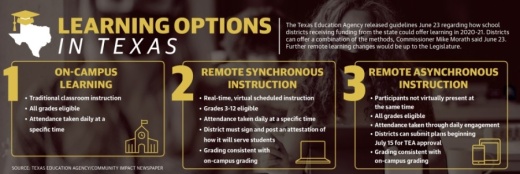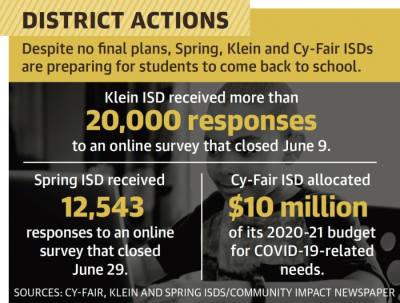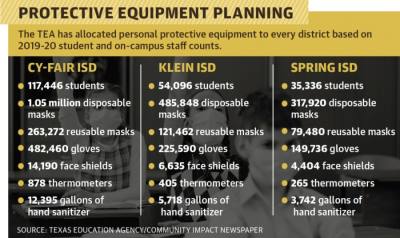After school districts across the Greater Houston area closed in mid-March and quickly shifted to remote learning for the remainder of the 2019-20 school year, district officials are now faced with crafting budgets and calendars for the upcoming school year that can accommodate the unknown.
“We’ve been challenged quite a bit throughout this budget process, throughout this entire spring semester—changes everywhere you turn,” SISD Chief Financial Officer Ann Westbrooks said following the board’s approval of the 2020-21 budget June 24. “Even though it’s a lot of uncertainty ahead of us, we feel as though we have a good team. We’ve done a lot of great work, and we’re meeting the challenge every time it comes at us.”
To assist districts in navigating these uncharted waters, the Texas Education Agency has released some guidance throughout the summer upon which school districts will base their plans. However, many questions still remain surrounding the logistics of holding in-person classes during a pandemic.
Finding flexibility
On June 16, the TEA released guidance acknowledging the 2020-21 school year is likely to be disrupted due to COVID-19 and outlined school calendar scenarios that can adjust for learning loss and minimize disruptions. These recommendations, while not required, include implementing an intersessional calendar, which would include longer breaks throughout the school year to provide flexibility or adding up to 30 days on top of the minimum required 180 days of instruction.
Following this guidance, both KISD and CFISD opted to keep their previously approved 2020-21 instructional calendars while extending their respective school days by 10-15 minutes according to grade level. District officials said the added learning time equals about eight additional school days and will provide a buffer in the event of future closures caused by inclement weather or COVID-19.
“We opted to keep our calendar the same, and yes, we did add some time to the school day to build us up a little cushion of eight days in case we have to let school out,” CFISD Superintendent Mark Henry said June 16. “I know it’s not ideal for everyone, but we thought that was a good way to approach this situation.”
In contrast, SISD opted to revise its previously approved 2020-21 calendar, which would have run Aug. 17-May 28, and switch to a TEA-recommended intersessional option, which runs Aug. 17-June 25. CFISD and KISD end the school year May 27 and 28, respectively.
“The administration believes that our proposed 2020-2021 calendar will give us the flexibility to deal with whatever unknown scenarios we may have to face in this coming school year,” SISD Chief of School Leadership Lupita Hinojosa said in a May 28 board meeting. “We believe this proposed calendar will give us a way to maximize instruction even if we’re forced into another COVID-19-related school closure.”
While district officials said the calendar change was met with some criticism from the SISD community, Superintendent Rodney Watson said he stood by the board’s approval.
“It’s important to note that every school district sees their own unique situation different,” Watson said May 28. “So, for example, ... there are a few districts that say very straightforward, ‘We don’t have a [COVID-19] slide. Our kids are fine. They will be well. We don’t have to plan for that.’ But their socioeconomic status, level of the needs of their kids and their community is totally different from ours.”
Two days after the TEA released calendar guidance, Gov. Greg Abbott told state lawmakers June 18 that students would be returning to Texas public schools in the fall. However, as positive coronavirus cases continue to reach all-time highs across the Greater Houston area, district officials said parents have already voiced concerns about the effect in-person classes could have on the health of their children.
Ironing out options
On June 23, the TEA released guidance giving school districts two options to deliver instruction remotely alongside on-campus learning to receive state funding. Those options include synchronous, or real-time, and asynchronous, or self-paced, remote learning. Updates to guidance June 25 said students and families will choose how they “attend” school, be it an on-campus, remote or hybrid model.
“I’ve received emails from parents asking that their kid be allowed to stay home next year for at least the fall because they’re not comfortable with their child coming back with the possibility of getting the coronavirus. And so, as I’ve talked with people, they’re from one end of the spectrum to the other end of the spectrum,” Watson said during a June 5 meeting.
In preparation for the unknown, the districts have gathered community input this summer through online surveys and listening sessions. They have formed committees and response plans for various COVID-19 scenarios ranging from almost business as usual to schools closing and switching to remote learning as they did this spring.
“I just finished listening sessions with almost 950 people from across Klein ISD, ... and I’m grateful for the feedback and the thoughtfulness and the trust and understanding of the concern that people are experiencing as we think about the 2020-21 school year,” KISD Superintendent Jenny McGown said in a June 22 meeting.
To better arm school districts, the TEA announced plans June 15 to distribute personal protective equipment to districts based on 2019-20 student and on-campus staff counts.
Additionally, CFISD’s 2020-21 budget includes $10 million in funding needs related to COVID-19. SISD’s 2020-21 budget includes contingency funds that can be used to cover unanticipated COVID-19 expenses, and KISD officials said budget amendments will be made as needed to cover COVID-19 expenditures.
As COVID-19 scenarios continue to evolve, district officials are also working to address logistical issues such as class configurations, transportation and the use of common areas such as playgrounds, cafeterias and libraries. However, guidance from the TEA on these details is forthcoming.
Danica Lloyd, Anna Lotz and Adriana Rezal contributed to this report.







